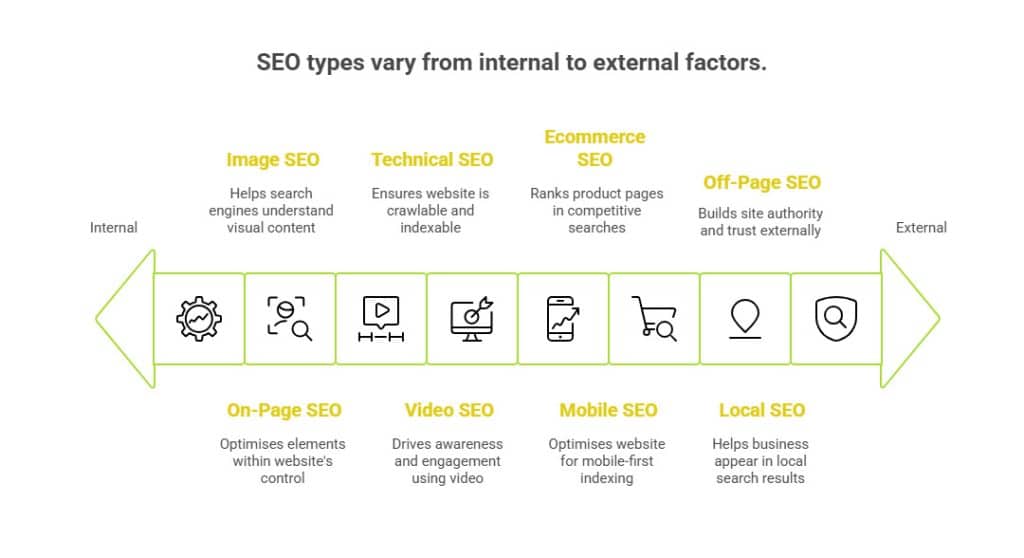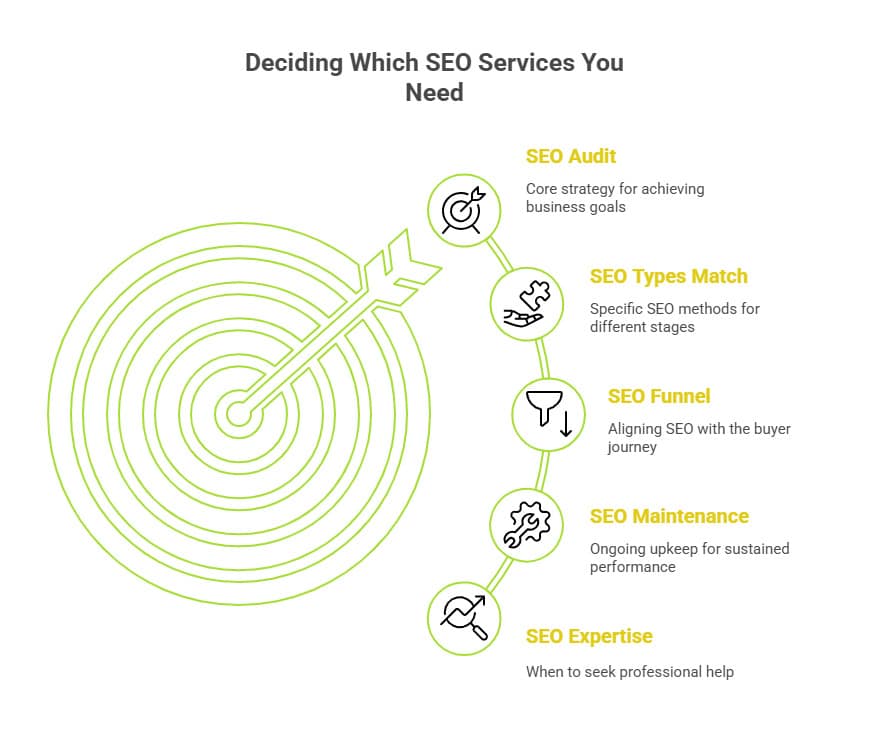You’ve built a website. Maybe even added some blogs, updated your homepage, and set up a few backlinks. But traffic? Still a trickle.
Here’s the thing: SEO isn’t one-size-fits-all. To actually climb the search rankings, you need to use different types of SEO that work together to improve visibility, performance, and user experience. Whether you’re running a local business, an eCommerce store, or a B2B service site, understanding the types of SEO in digital marketing can help you identify what your site is missing and where to focus next.
In this guide, we’ll break down what each SEO type does, how it fits into your digital strategy, and which ones are most relevant depending on your goals.
Let’s start with the basics: what are the different types of SEO, and how many should you really care about?
What Are the 8 Different Types of SEO?

Infographic of Different Types of SEO
Not all SEO is created equal. Depending on your website’s size, structure, and goals, you may need to prioritise one type of SEO over another. For example, a fast-scaling B2B SaaS company may benefit more from a clean technical foundation and authoritative link-building, while a local business might rely heavily on citation management and Google Business Profile optimisation.
Let’s break down the main types of SEO and the strategic role each plays in improving your rankings, visibility, and performance across search engines.
1. On-Page SEO
On-page SEO is the foundation of your website’s search performance. It involves optimising elements within your control, such as content, keywords, HTML tags, and internal linking structure. Here’s what you need to make sure-
- Target keyword placement across titles, headers, and body text.
- Use of semantic keywords to match search intent.
- Content hierarchy with proper heading tags (H1-H3).
- Meta descriptions that drive click-throughs.
- Internal linking to cluster pages and key product/service URLs.
2. Off-Page SEO
Off-page SEO builds your site’s authority and trust in the eyes of search engines. It happens outside your domain, but has a direct impact on your rankings.
Key components include:
- Earning backlinks from high-authority and contextually relevant sites.
- Digital PR, guest posts, and brand mentions.
- Participation in niche forums, podcasts, and roundups.
- Reputation management via third-party review platforms.
3. Technical SEO
Technical SEO ensures that your website is crawlable, indexable, and loads fast on all devices. It’s often the first thing that breaks as your site scales, especially if you’ve launched new features or migrated CMS platforms.
Key components include:
- Site architecture and internal linking strategy.
- Page speed optimisation (image compression, JS deferment).
- Mobile responsiveness and Core Web Vitals (LCP, FID, CLS).
- Proper use of canonical tags and hreflang attributes.
- Fixing crawl errors, redirect chains, and broken links.
4. Local SEO
Local SEO helps your business appear in location-based search results, particularly the map pack. It’s essential for service providers, retail stores, and any business that relies on local foot traffic.
Key components include:
- Google Business Profile optimisation.
- Local citation building and NAP consistency.
- Location-specific landing pages.
- Earning and.
- Embedding maps and local schema.
5. Mobile SEO
Google has moved to mobile-first indexing, meaning that if your mobile site experience is poor, your rankings will suffer regardless of desktop quality.
Key components include:
- Responsive design and viewport settings.
- Compressing images for fast mobile loading.
- Clear, thumb-friendly navigation.
- Avoiding intrusive interstitials and pop-ups.
- Testing using Google’s Mobile-Friendly Test tool.
6. Image SEO
Image SEO helps search engines understand your visual content, making it indexable and discoverable in image search and rich results.
Key components include:
- Descriptive filenames and relevant keyword-optimised alt text.
- WebP or AVIF formats for performance.
- Using structured data to tag galleries.
- Lazy loading for speed without UX trade-offs.
7. Video SEO
With YouTube being the second-largest search engine, video SEO is essential for brands using video content to drive awareness and engagement.
Key components include:
- Adding structured data to embed key moments.
- Hosting on fast-loading CDNs.
- Providing transcripts and closed captions.
- Optimising thumbnails, titles, and descriptions.
- Ensuring mobile and cross-browser compatibility.
8. Ecommerce SEO
Ecommerce SEO focuses on making product and category pages rank in competitive search environments. It’s about clean architecture, data accuracy, and intent-aligned optimisation.
Key components include:
- Keyword mapping to product categories and filters.
- Product schema for rich snippets (price, rating, availability).
- Canonical URLs for variants to avoid duplication.
- Review aggregation and user-generated content.
- Fast-loading checkout experiences to retain ranking signals.
How to Decide Which SEO Services You Need?

Infographic of How to Decide Which SEO Services You Need
Every website has different goals, weaknesses, and growth stages, so blindly applying all types of SEO isn’t cost-effective or strategic. The right approach depends on where your current bottlenecks are and what outcomes you want to achieve.
Here’s how to figure out where to focus your SEO investment:
1. Audit Your Current SEO Performance
Before you invest, know where you stand. Use tools like Google Search Console, Semrush, or Ahrefs to evaluate three key areas:
- Traffic & Rankings: Are your most important pages getting visibility for the right keywords?
- Technical Health: Are crawl issues, poor Core Web Vitals, or broken pages preventing proper indexing?
- Backlink Profile: Does your domain have the trust signals needed to compete?
Example: If your blog is generating lots of impressions but few clicks, the issue might be with your title tags or a mismatch between content and searcher intent – classic on-page SEO problems.
2. Match SEO Strategy to Your Business Stage
Every business stage demands a different focus. A startup doesn’t need the same SEO stack as a 5-year-old brand.
If you’re launching a new site, start with technical SEO: set up proper site architecture, XML sitemaps, robots.txt, and initial keyword mapping.
Getting traffic but not leads? You may need stronger on-page UX, clearer CTAs, or content that speaks to buyer intent – not just general search topics.
Seeing stagnant rankings despite regular blogging? That’s a cue to strengthen your backlink profile and fix deeper site structure issues.
Running a multi-location business? Your growth depends on local SEO – Google Business Profile optimisation, consistent NAP citations, and location pages.
3. Map SEO Services to the Funnel
SEO isn’t just about getting traffic – it should move users through the funnel.
- At the Top of Funnel (TOFU), invest in content SEO. Think blogs, FAQs, and glossary hubs that answer broad questions.
- In the Middle (MOFU), focus on internal linking and technical SEO to support comparison pages and product education.
- At the Bottom (BOFU), double down on conversion-driven pages. These need CRO + on-page SEO tuned for speed, clarity, and trust.
The goal? Bring in the right traffic – and convert it.
4. Don’t Skip Maintenance SEO
Even if your SEO is performing well now, small technical or content mistakes can compound over time. Routine upkeep is essential for long-term rankings. This includes:
- Cleaning up broken links and removing outdated redirects.
- Refreshing old content to stay current with user trends.
- Rebalancing internal link flows and anchor text strategy.
- Monitoring Core Web Vitals, crawl errors, and mobile usability.
- Tracking competitor SERP movements so you’re not caught off-guard.
Think of it as SEO insurance – quietly preventing bigger traffic losses.
5. Know When to Bring in an Expert
If audits reveal complex issues like:
- Duplicate content due to URL parameters.
- Non-indexed critical pages.
- Stagnant rankings despite good content.
- Cannibalisation across blogs and product pages.
…it’s time to bring in a specialist or agency like Wild Creek Web Studio. These problems often require advanced tooling and cross-functional fixes (e.g. development + SEO strategy).
Why Top B2B Brands Trust Wild Creek Studio with Their Search Visibility?
Tired of SEO reports that show rankings, but not revenue?
Most B2B brands struggle with agencies that treat SEO like it’s B2C, chasing keywords without aligning with your sales funnel or buyer personas. That’s where Wild Creek Web Studio changes the game.
We help B2B companies fix what actually holds them back:
- Crawl waste from bloated category pages and outdated blogs.
- Lack of bottom-funnel visibility on service and demo pages.
- Thin content that ranks but doesn’t convert.
- Broken internal link flows that bleed authority.
We’ve worked with SaaS brands, B2B platforms, and technical service providers to engineer SEO strategies that plug into real business outcomes, pipeline, signups, and sales-ready leads.
From technical SEO audits to content clusters mapped to each funnel stage, we build systems that drive organic visibility where it matters most.
Because SEO should move more than just your search rankings, it should move your business forward.
Book Your First Consultation for Free!
Conclusion
SEO doesn’t deliver overnight wins, but done right, it compounds like interest. Understanding the different types of SEO isn’t just academic; it’s the first real step toward diagnosing gaps in your online presence and fixing them with intent.
Whether your site suffers from poor url structure, weak title tags, missing header tags, or lacks relevant content tailored to your target audience, each SEO type, from technical elements to local search results, plays a critical role in shaping your search engine optimization success.
Aligning your SEO efforts with your broader content marketing and digital marketing strategy ensures that you’re reaching potential customers at every touchpoint, on desktop, mobile, or even across social media marketing platforms.
If you’re aiming for lasting organic traffic, higher page authority, and meaningful website traffic, don’t just “do SEO.” Choose the right mix of strategies. Audit your gaps. Refine your plan. And keep evolving to stay visible in a world that’s always searching.
Frequently Asked Questions
What are the types of SEO for a SaaS brand?
The main types of SEO are on-page, off-page, and technical SEO. Additional strategies include local SEO, international SEO, and mobile SEO, each playing a unique role in improving search engine visibility and attracting the right audience.
How many types of SEO are out there?
There are three core types of SEO, on-page, off-page, and technical. However, when you consider SEO optimization for mobile devices and screen sizes, global markets, or local customers, the list expands to include up to seven different types of SEO.
What are the types of SEO in digital marketing?
What are the types of SEO explain in detail- In digital marketing, the most common types of SEO include on-page, off-page, technical, local, mobile, and international SEO. Each helps improve online visibility, drive organic traffic, and position your brand in search engine results.
Why is understanding different types of SEO important?
Knowing the different types of SEO lets you target gaps in website content, structure, and outreach. It’s the best practices for effective keyword research, competitor analysis, and link building, all of which influence your online store search engine rankings.
How do social media and SEO work together?
While social media doesn’t directly boost search engine rankings, it fuels brand awareness, generates social signals, and amplifies relevant content. Channels like social media marketing support your SEO techniques by bringing visibility to your site and content.
